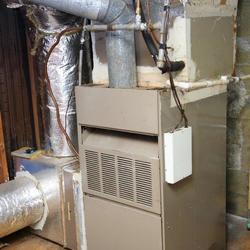A Beginner Buyer’s Guide to Purchasing the Perfect Furnace for Your Home
Your furnace is your companion that keeps you cozy through the frigid Minneapolis winters.
So it’s crucial you find the one that will keep you comfy while not costing you an arm and a leg to use.
To find the perfect furnace for your family, keep in mind these 4 important factors:
- Size (measured in BTUs)
- Energy efficiency and furnace type
- Stage/burner type
- Blower type
Furnace size (measured in BTUs)
The furnace’s size will strongly affect:
- How comfortable you’ll be
- How efficiently the furnace will run
- How long the furnace lasts
So make sure the furnace’s size fits your home’s heating needs—like sizing a shoe for a foot (just right).
You see, if a furnace is too small then:
- You won’t feel comfortable on very cold days
- The furnace will run constantly, running up your energy bill
If the furnace is too large then it will turn on and off too often (short cycle) which:
- Hurts the furnace’s energy efficiency
- Lowers the lifespan of the furnace
- Leaves your uncomfortable
So here’s some good news: You don’t have to figure this out. A professional heating contractor should perform a Manual J Heat Load Calculation to find the size you need.
Your big takeaway: Find a top-notch heating contractor to perform a heat load calculation to find the furnace size your home needs.
Energy efficiency and furnace type
Just like cars have a MPG rating to show how efficiently they use gas, furnaces have the AFUE rating to show how efficiently they turn energy into heat.
For example, a furnace with an AFUE of 80% turns 80% of it’s energy (gas) into heat, while the rest is lost up the flue pipe. Put another way, that’s 20% it’s wasting, costing you money.
Now, here’s where things get tricky. You know how a more efficient car usually costs more money, right? The same goes with a furnace.
Furnaces are split into 2 different types, each with varying AFUE efficiencies:
- Conventional furnace (mid efficiency): 80%-83% AFUE
- Condensing furnace (high efficiency): 90%-98% AFUE
Because condensing furnaces cost more to buy and install, you have to ask yourself, “Do I want to (or have the budget to) pay extra upfront to save more money in the long run?”
If you answer “yes” then you want a high-efficiency condensing furnace.
if you answer “no” then you want a mid-efficiency conventional furnace.
You’ll only know if the high-efficiency furnace will be worth it once you compare:
- Multiple estimates for different furnace types and efficiencies to the...
- Potential savings of those different furnace types and efficiencies.
You’ll get the estimate from a heating contractor. But you can see how different AFUE efficiencies will save you over a 5-year, 10-year and 15-year period using this energy efficiency savings calculator.
Your key takeaway: Consider your budget. If you can afford a higher efficiency furnace, see if it makes sense to by it by comparing various installation costs and long-term efficiency savings.
Stage/burner type
The stage/burner affects how comfortable you are and how efficiently the furnace will run.
There are 3 stage/burner types:
- Single-stage
- Two-stage
- Modulating
A single-stage burner runs at full blast or not at all. So you’ll have more peaks and valleys of temperature, decreasing comfort and increasing energy bills.
A two-stage (or dual-stage) burner allows the furnace to run at two different settings when running: high (full blast) and low. The low setting is for mildly cold days, allowing it to run more often (keeping your warm), without using as much energy (saving you money).
A modulating burner (most efficient) adjusts its flame to any point between off and high, keeping your home’s temperature constant while lowering your energy bills.
Blower type
The blower is what (you guessed it) blows air out your vents. Like the burner type, the blower type affects the furnace’s efficiency and how comfortable you’ll be.
There are 3 different types of blowers:
- Single speed: Runs full blast or off.
- Multi-speed: Runs at 3 different speeds (low, medium, high) depending on your needs.
- Variable speed (most efficient): Can incrementally adjust how much air it blows based on your heating needs, just like the modulating burner.
Need an expert opinion? We can help!
We know. This is a lot to take in. But if you’re feeling lost, just ask our heating experts for help.
Or, if you’re ready to get a furnace installation now, contact us today to schedule a free estimate.
If you’re looking to replace the air conditioner with the furnace, check out our central air conditioner buyer’s guide.

